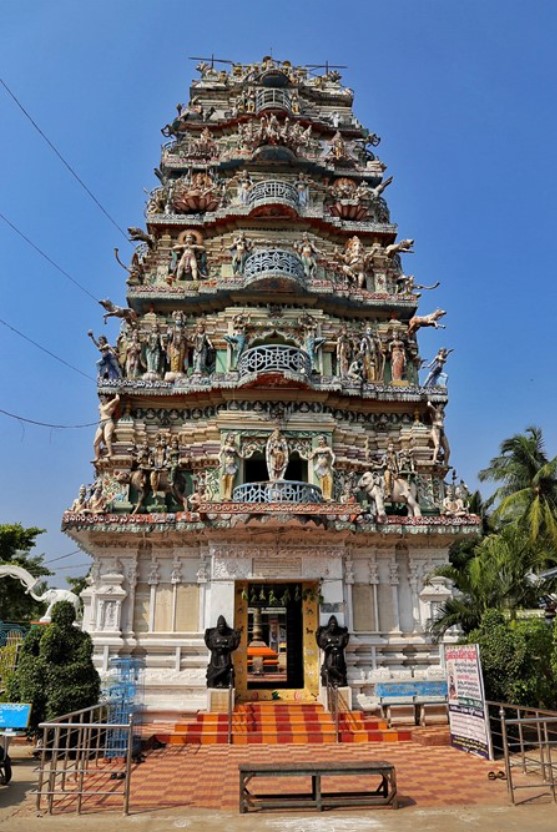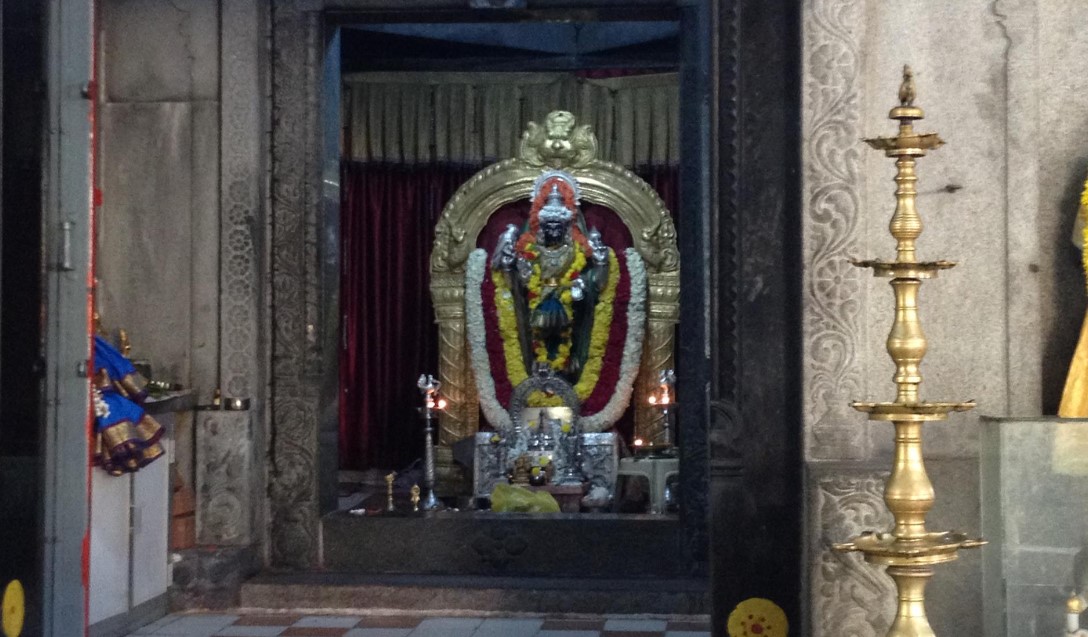Penugonda Vasavi Temple also known as Shri Vasavi Kanyaka Parameshwari located at Penugonda in Andhra Pradesh and is the family deity or ‘kula devatha’ of the Arya Vysya community ( as mentioned in the Vasavi Puranam ).
About Penugonda Vasavi Temple
Because Penugonda is the birthplace of “Vasavi Matha,” the temple is known as the Penugonda Vasavi Kanyaka Parameswari temple of Shri Vasavi Kanyaka Parameshwari, the sacred goddess of Vysyas.

The sacred Penugonda Vasavi Temple, appears in a number of ancient religious scriptures. Vasavi Kanyaka Paratneswariwas was noted for her beauty, according to mythology.
Sri Nagareswaraswamy, Mother Kanyakaparameswari, and Mahishasuramardini are enshrined in the holy temple.
The temple was created in strict compliance with vastu sastra, therefore it has strong prakars, tall gopuras, huge courtyards, multiple minishrines, vast garbagrihas, grand mukhamandapas, and so on.

It faces east, and a lofty tower atop the vast mahadwara lures tourists with exquisite sculptural pieces adorning it from top to bottom and on all four sides.
In front of it is a large courtyard with many buildings containing the office, poultry, and staff quarters.
There are various mandapams in the second Prakara with charming deities such as Vinayaka, Navagrahas, Lord Venkateswara, and Kaala Bhairava, as well as finely sculpted colourful sculptures of Mother Kanyakaparameswari standing in a fire pit with her parents by her side and a gorgeous mirror house.
Nagareswaraswamy’s garbha griha is quite spacious, and its spick and span, along with the elevated vedh for the lingam in the centre, is masterfully conceived and elegantly implemented.
The towering Shiva linga, which is mounted on a large, tall platform and is decorated with colourful garlands and triple lines set with diamonds, is so alluring that when devotees first catch sight of it, they immediately lift their hands in adoration.
The two other garbha grihas, Mahishasuramardhini and Vasavamba, are magnificent and mesmerise the admirers with their sparkling jewels and vibrant attire.
A single darsan makes a lasting effect on the devotees’ minds and beckons them back time and time again.
Sri Vasavi Kanyaka Parameswari Temple History
Penugonda Vasavi Temple, which is located in Penugonda, a town in the West Godavari District of Andhra Pradesh, is one of the numerous temples in South India’s Treasure House.
The temple has an impressive seven story, multicoloured (Gali Gopuram) tower with lovely architecture. This Penugonda Kshetram is revered by Vysyas and is known as the “Kasi of Vysyas.”
Kusuma Sresti or Setty was the Setty king of Vysyas and was known as Pedda Setty (Elder among Settys) . His territory was a Vassal state of Vangi Desa (Vanga Kingdom). Vangi was ruled by Vishnu Vardhana (Vimaladitya Maharaja).
During the 10th and 11th centuries A.D., Penugonda (Jestasailam) city served as the capital for all 18 paraganas rules by Vishnu Vardhana.
Kusuma Sresti and his wife Kusumamba worshipped Lord Siva (Nageswara Swamy).
Despite being married for a long time, the pair did not enjoy peace of mind because there was no heir to the throne. They did not had any children.
So they were grieved because their numerous prayers and sacrifices had been ineffective.
They went to their Kula guru, Bhaskara Acharya, who was also a Komati and was respected as a Komati Brahman because of his knowledge of the shastras.
He suggested that they carry out the Puthra Kamesti Yaga that Dasharatha had done.
So they started the yagna. The Gods were pleased and sent prasadam—blessings from the gods—through the fire God Yagneswara.
They consumed the Prasadam with devotion, and a few days later Kusumamba’s pregnancy symptoms were discovered.
She revealed strange wishes that suggested she would have children who would battle for the well-being of everyone.
There was joy everywhere in the springtime. In the middle of this natural splendour, Kusumamba gave birth to twins on Friday, the 10th of the Telugu month of Vaisaka, at dusk, at the time of the convergence of Kanya and Uttara Nakshatram (Virgo).
One twin was a boy and the other a girl. The female child’s name was Vasavamba, and the boy’s was Virupaksha.
Childhood traits for an owerful monarch were displayed by Virupaksha, whilst Vasavi had a preference for art and architecture, a love of music, and a philosophical outlook.
Virupaksha studied the Puranas, fencing, horseback riding, martial arts, archery, statecraft, and other subjects from Bhaskara Acharya that were necessary for him to rule his territory.
Vasavi was happy to be an intelligent woman who had studied philosophy and the beautiful arts.
When Virupaksha reached the legal marriage age, he married Ratnavati, the daughter of Aridhi Setty of Aelur Town.
When King Vishnu Vardhana went on an excursion to expand his realm, he stopped in Penugonda, where King Kusuma Setti welcomed him, led him in a procession, and hosted a felicitation ceremony in the colourful auditorium.
Vimaladitya (Vishnu Vardhana) spotted Vasavi among the crowd and fell madly in love with her.
He felt he could not live without her and was determined to marry her. He sent a minister to enquire about her.
The desire of Vishnuvardhana (Vimaladitya) was like a death blow to Kusuma sresty. He was neither in a position to accept it nor to deny.
The fact that the Emperor was already married, was much older, the difference in caste and the fact that he was not in a position to prevent this from occurring all caused extreme stress for Kusuma Setti.
He discussed these issues with his closest relatives and friends, and they all agreed that Vasavi should make the decision.
Vasavi stated unequivocally that she wished to be a unmarried for the rest of her life and would not be concerned with worldly issues.
Kusuma Setti sent a word of denial to King Vishnuvardhana. The king was enraged and dispatched a Battalion with orders to strike viciously and capture Vasavi.
The courageous Komti’s of Penugonda destroyed Vishnuvardana’s army by employing Sama, Daana, Bheda, and lastly Danda methods.
At this critical point, Kusuma Sresti summoned the Chiefs of all 18 cities and the leaders of all 714 Gotras to a Great Conference in the presence of Komati Kula Guru Bhaskara Acharya.
There was disagreement at the conference. “Those who are born must die, and cowards die many times before their death, but the valiant taste death only once,” the Chiefs of 102 Gotras decided.
Can’t the spark burn a pile of straw even if the opponent is stronger? As a result, let us fight for a worthy cause. The chiefs of the other 612 Gotras, on the other hand, believed that a marriage relationship would be safer and more profitable.”
“We must safeguard our respect even at the cost of our lives,” remarked Bhaskara Acharya. Kusuma Sresti was sparked by these remarks.
Despite the fact that they were a minority, he was adamant about not marrying his daughter Vasavi to the king.
The Komti’s togetherness was shattered by this occurrence. The Emperor, like an injured Cobra, seized command of his vast army, determined to crush his adversaries.
In Penugonda, agreements were made with supporters of the 102 Gotras to deal with the consequences.
This is when Vasavi entered into scene and said: “Why should there be bloodshed among us for the sake of a Girl? Why sacrifice the lives of soldiers for our selfish desire.
It is better to give up the idea of war. Instead, let us rebel in a novel way. We can control war through non-violence and self-sacrifice.
Only people with strong will power and moral strength can participate in this kind of self- sacrifice.
Vasavi’s new idea was delightful to her parents and they decided to act in accordance with Vasavi’s directions.
Vasavi directed that 103 Agnikundas (fire pits) be strategically placed at the sacred site of Brahmakunda on the banks of the Godavari.
The entire city was celebrating that day as a festival. Then Vasavi addressed the 102 Gotra couples, “Will you plunge into this holy fire with me?” Every single one of them enthusiastically agreed.
They felt that Vasavi was an incarnation of God and asked her to reveal her true essence, or swarupa.
Ma Vasavi smiled and revealed her actual self, which shone with a gleaming light that rivalled the brightness of the sun. “I am the incarnation of Adiparashakthi,” she explained.
I have come here in Kaliyuga to protect the dignity of women and Dharma, to defeat Vishnu Vardhana and to demonstrate to the world Komti’s magnanimity.
Like Sati Devi, who was humiliated and entered the holy fire, I too will enter the other world.
Kusuma sresty had a previous birth as a renowned Saint named Samadhi, and he hoped to obtain redemption along with the people of 102 Gotras.
That is why I urged you all to participate in Atma Balidana.” Vasavi counselled the audience on patriotism, honesty, social responsibility, and tolerance.
Devi vanished as soon as she spoke the heavenly words and they saw her in human form. After contemplating on their Gods, they all entered holy fire.
Despite the ill Omens, Vishnuvardhana marched on and arrived at Penugonda’s main gateway.
Then his investigators reported on everything that had happened in the city. The huge shock was too much for him, and his heart splintered into pieces.
He collapsed, vomited blood, and died.
Vasavi’s self-sacrifice and the death of Vishnuvardhana were the buzz of the town.
People denounced Vishnuvardhana’s actions while honouring Vasavi and her nonviolent principle.
Raja Raja Narendra, Vishnuvardhana’s son, rushed to Penugonda and apologised for the event.
Later, Virupaksha consoled him, saying, “Brother, let us learn and formulate the present and future on the solid foundation of the past.”
Vasavi had come to the people’s aid without causing too much carnage. Her nonviolence yielded a positive outcome,” and from now on, Komatis will not fight or control states, but instead participate in service to others, including trade, agriculture, and so on.
Under the direction of Komati Kula teacher Baskara Acharya, Virupaksha visited numerous pilgrim centres such as Kasi, Gaya, and others.
They installed 101 lingams in Penugonda to mark the pilgrimage.
As a mark of respect, Raja Raja Narendra erected a Vasavi statue. From that day on, all Komtis performed Pooja to her, and she is now known as Komatikula Devata-Vasavi Kanyaka Parameswari.
Vasavi’s life is noteworthy for her belief in nonviolent religious values and her defence of women’s rights.
She became eternal since she was mostly responsible for spreading Komatis’ renown around the world.
Vasavi, who had eschewed worldly pleasures, gained the hearts of Komatis and is a champion of peace and nonviolence who will be remembered by everybody.
How to reach Penugonda Vasavi Temple?
If you plan to travel by train , the nearest Railway Station To Penugonda is.
Indian Railways operates a train from Secunderabad to Tanuku twice daily.
| Sr No. | Station Name | Station Code | Distance |
|---|---|---|---|
| 1 | Velpuru Railway Station | VPU | 8 Km |
| 2 | Relangi Railway Station | RLG | 8 Km |
| 3 | Tanuku Railway Station | TNKU | 9 Km |
| 4 | Chinta Parru Halt Railway Station | CTPR | 9 Km |
| 5 | Attili Railway Station | AL | 9 Km |
| 6 | Manchili Railway Station | MCLE | 9 Km |
| 7 | Lankalakoderu Railway Station | LKDU | 10 Km |
| 8 | Palakollu Railway Station | PKO | 10 Km |
| 9 | Aravalli Railway Station | AVLI | 10 Km |
| 10 | Sivadevunichkla Railway Station | SVDC | 10 Km |
If you are planning ti tarvel by Air, the nearest airport to Penugonda is Rajahmundry (RJA).
From Bangalore the distance to the temple is around 800Kms and will take 14 hrs of drive.
Hyderabad to Penugonda is approx 430 kms and will be around 8 hrs of drive.
you may also like: Gnana Saraswati Temple Basar – Adilabad – Temple for Akshara abhyasam

